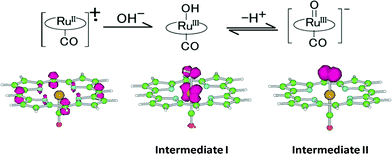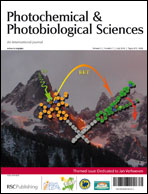Two key reaction intermediates in the photochemical oxygenation of alkene sensitized by carbonyl-coordinated ruthenium(II)–porphyrin complex, with water acting both as an electron and oxygen atom donor, are postulated. Under the low concentration of hydroxide ion (<2 × 10−3 M) added to the reaction mixture of tetra(2,4,6-trimethyl)phenylporphyrinatoruthenium(II) (RuIITMP(CO)), K4PtCl6 as a sacrificial electron acceptor, and cyclohexene as a substrate in aqueous acetonitrile, the major reaction product was cyclohexaneoxide (“Epoxide”), while it drastically decreased along with an increase of 2-cyclohexenol (“Alcohol”) by increasing the amount of hydroxide ion (>2 × 10−3 M). The tendency was more obvious in the case of tetrasodium tetra(4-sulfonate)phenylporphyrinatoruthenium(II) (RuIITSPP(CO)) in aqueous solution. The “Alcohol” was exclusively formed in the higher concentration region of OH−, strongly suggesting the presence of acid–base equilibrium among two reaction intermediates. Theoretical DFT calculation indicates that the hydroxyl-coordinated one-electron oxidized Ru–porphyrin (Intermediate (I)), which is formed by the axial ligation of hydroxide ion to the cation radical of Ru–porphyrin generated through electron transfer from the excited triplet state of the sensitizer porphyrins, suffers deprotonation of its axial hydroxide group to lead to an oxo-type complex (Intermediate (II)) formation. The DFT calculation also indicates that the electron spin on the Intermediate (I) is shared by the axial oxygen atom and the central Ru metal, while it is mostly localized on the axial oxygen atom to behave as an oxygen radical in the case of the Intermediate (II). These are very strong indications towards understanding how OH− (water molecule) is oxidatively activated on the Ru center: the water molecule is serving as an electron donor ion in the redox cycles. Theoretical calculation predicts that Intermediate (I) allows the epoxidation of alkene and Intermediate (II) can proceed through hydrogen abstraction from the substrate and is rebound to form hydroxylated compound, “Alcohol.”

You have access to this article
 Please wait while we load your content...
Something went wrong. Try again?
Please wait while we load your content...
Something went wrong. Try again?


 Please wait while we load your content...
Please wait while we load your content...